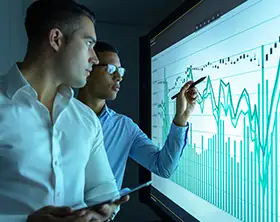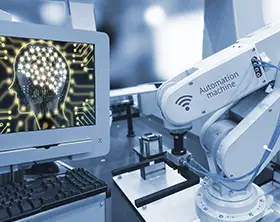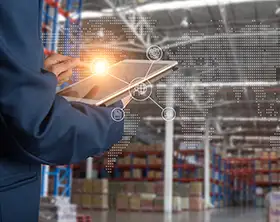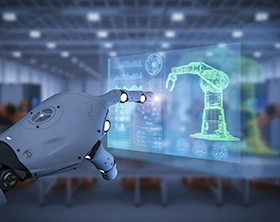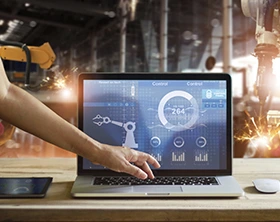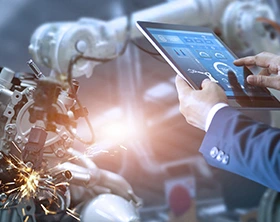Digital Twins and AI in Manufacturing: Benefits and Opportunities
What is a Digital Twin?
A digital twin is a virtual replica of a system or a facility that closely emulates its physical characteristics. Unlike static 3D models or regular simulations, digital twins are powered by real-time data from the modeled object itself, auxiliary sensors (IoT and edge devices), and other operational systems (e.g., energy management platform).
A digital twin is also more than an interactive prototype or a digital proof-of-concept (PoC), created once to evaluate a new workflow, for example. Such systems are mostly based on historical data or assumptions, while digital twins continuously mirror the assets’ current state.
Although the term “digital twin” may sound new, it’s actually not. Back in the 1960s, NASA developed a “living model” to help the Apollo 13 mission recover after an oxygen tank explosion and successfully make it home. Since then, NASA developed a multitude of other “digital twin” models to test physical systems for performance and durability before launching the developed space shuttles into open space.
The idea of creating data-driven replicas to model complex operational processes and perform remote monitoring soon traveled to other industries. Today, digital twins are actively used in sectors like telecom, energy, and manufacturing.
How Are Digital Twins Used in Manufacturing?
Digital twins offer business leaders the ability to model and stress-test complex asset performance in as close to real-world conditions as possible. For example, evaluate and optimize material behavior or measure heat development during certain operating conditions.
Such capabilities are particularly valuable in industries like aerospace, defense, and automotive, where actual tests can be expensive (or downright dangerous) to perform. The Renault Group, for example, relies on digital twins to deliver new vehicle models. The Design team can model the bodywork and interior with high precision to test different configurations and then share digital proposals with the Engineering department via a secure cloud.
For already deployed systems and facilities, digital twins enable better predictive maintenance. Instead of performing manual assessments (which may often require tedious field trips), operators can review asset conditions and performance data from a digital dashboard to determine the optimal servicing schedule. GE engineering team, for example, developed a digital twin for the Haliade 150-6 wind turbine’s yaw motors. The twin eliminates the need to constantly check the turbine’s internal temperature, which is difficult to estimate. Thanks to this, operators can evaluate how the motors perform under different strains and fine-tune their performance for maximum efficiency.
Finally, digital twins also help maintain optimal operating conditions at the manufacturing centers and even locate opportunities for cost savings. With the recent hike in energy prices and growing pressure to reduce carbon emissions, large manufacturers could benefit from extra advice on resource optimization. Digital twins can help locate areas of waste — be it suboptimal HVAC system configurations or avoidable material waste.
For example, LG Electronics created a 3D replica of its entire logistic system for one of its factories in Korea. Powered by edge computing, deep learning, and machine learning, the digital twin enables the modeling of production process analytics in virtual reality, can predict defect issues that will occur in the next 10 minutes, and provides the exact parts and materials for assembling each appliance. In one year of operations, the digital twin helped to reduce defective product return rates by 70% and energy usage by 30%.
Overall, digital twins in manufacturing carry a host of quantifiable benefits: from optimized development times (between 20% to 50%) to up to 25% lower CO2 emissions. However, these gains can be further magnified by fusing digital twins and artificial intelligence (AI).
Combining Digital Twins and AI: Emerging Use Cases
In the most simplistic terms, a digital twin is a collection of different cross-correlated data points, representing the current state of the system or process. The early deployments often rely on statistical data analytics methods to deliver descriptive and diagnostic analytics. By embedding more advanced machine learning and deep learning algorithms (which make up AI), business leaders can obtain even richer insights from predictive analytics and optimize asset performance using data-based prescriptive actions.
P&G, for example, already has several digital twin models running across its factories in Egypt, India, Japan, and the US. Now the company is seeking to harness further improvements in manufacturing efficiencies with the help of AI. The company plans to digitize and integrate data from over 1000 manufacturing sites globally and enhance its real-time operational visibility using Microsoft Azure’s offering for IoT, AI, and edge computing.
The ultimate goal: Leverage AI to support production decisions at every level, “to predict outcomes and increasingly to prescribe actions through automation,” according to Vittorio Cretella, CIO of P&G. Thanks to available modeling and simulation tools, P&G already shorted the lead time for some new products from months to weeks. Now they want to enact real-time product quality checks directly on the production line, enable predictive equipment maintenance, and optimize energy and water usage across all its plants.
Although the above plans may sound ambitious, the current state of AI technologies, in combination with industrial IoT (IIoT) and 5G connectivity, already permits such advanced manufacturing automation scenarios. Below are several other operating scenarios, enabled by AI-powered digital twins.
Prescriptive Operational Insights
Digital twins allow manufacturers to capture and process huge volumes of data from assets in service: be it a standalone component like a circuit dashboard or the entire connected vehicle. By applying different machine learning modeling techniques to the available data, manufacturers can identify new opportunities for product enhancements.
Rolls-Royce created a digital twin platform for aggregating data from all the produced aircraft engines. Using historical asset data, the team created an optimized maintenance schedule, designed to maximize the lifespan of each engine, achieving up to 50% reduction in time between maintenance for some of its engines. It also suggests how to properly dispose of metal waste from parts when they reach their end of life.
What’s more, the company is also helping its clients achieve better optional outcomes. Since 2014, Rolls-Royce has helped one of its airline clients save over 200 million kilograms of carbon dioxide by suggesting flight route optimizations, using the data from its digital twin.
Infopulse, in turn, helped an international mining consortium reduce the volume of production defects with a predictive analytics solution. The custom model can estimate the probability of slab defects based on the product parameters (steel grade and gauge of sheets) with high accuracy. With fewer defects, the company can potentially produce an extra 250-300 steel sheets per month, plus benefit from optimized operating costs.
Real-Time Route Optimization for Logistics
Digital twins can also help optimize on-the-ground operations in logistics. Digital twins can model the movement of shipping containers or delivery vehicles to better estimate arrival times, optimize delivery routes, and ensure the proper handling of goods in transit (e.g., optimal temperature conditions for cold logistics).
DHL is working on a digital twin platform for replicating its customers’ entire supply chain. With the help of this tool, managers can simulate different fulfillment scenarios. For example, how creating extra stock locations could affect emission levels or the carbon reduction potential of shipping the same order via sea freight instead of air. An alpha version was presented in Valencia, Spain in June 2023 and a beta release is scheduled for 2024.
Lufthansa, in turn, is evaluating different digital twin scenarios for optimizing cargo operations, namely ensuring better monitoring and prediction of delays for improved delivery times. NAPA, a maritime software vendor, created a digital twin solution for optimizing sea routes. The twin aggregates data directly from the vessel’s onboard systems like ECDIS electronic navigational charts and automatic identification system (AIS) plus external ones like weather forecasts and the current list of no-go areas. Each digital twin combines real-time data with naval architecture models, data from past voyages, and port data into a dynamic model for the entire vessel. It can be used both for performance analytics and reporting, plus future route optimization.
Fleet managers can adjust routes to optimize the vessel's carbon footprint, for example, using real-time environmental information on the effects of wind or swell.
Quality Control with Computer Vision
Computer vision algorithms can derive information from images, videos, and other visual inputs to scan objects, detect performance anomalies, or digitize different physical parameters (e.g., current gauge measures). In other words: Such models can provide another pane of data to digital twins, plus enable real-time asset or process inspections.
Instead of visually quality-assessing goods on the assembly line for defects, you can set up automatic systems, offering a higher degree of accuracy than the human eye. Infopulse, for example, helped develop a remote gas turbine monitoring system that collects and operationalizes data from 250+ IoT sensors. It supplies the customer with high-precision analytics and real-time anomaly detection with a 93% accuracy rate.
Last year, HPE and NVIDIA implemented AI-based video analytics for quality control in its European manufacturing facility. The manual inspection process couldn’t keep up with over 1,000 potential server configurations that were possible on the production line. The team implemented an on-site edge-to-cloud architecture to train a custom deep learning model for performing digital quality audits. With the new system in place, out-of-the-box quality issues were reduced by 25%, while the inspection speed improved by 96 seconds per server.
The New Frontiers of AI Innovation in Manufacturing
Although leaders in space already had successful pilots and some also run large-scale productized AI systems, digital twin adoption is still in a nascent state and so is industrial AI. However, that is about to change. By 2027, the adoption rate of digital twins in manufacturing is expected to grow tenfold. Moreover, 57% of manufacturing leaders are experimenting with a range of small-scale AI pilot projects, while another 28% are implementing successful pilots, according to a 2023 survey by the Manufacturing Leadership Council.
Generative AI is also yet to make a strong impact on the manufacturing industry, though this is likely to happen soon. Large language models (LLMs), which are part of the gen AI suite of technologies, can help create conversational interfaces for digital twins, further commoditizing access to reach operational insights. Instead of generating custom reports, factory operations could directly ask Gen AI assistants to provide the latest data on asset performance or suggest the optimal servicing sequence for monitored equipment.
As Todd Edmunds, global CTO for Manufacturing at Dell Technologies, summed it up quite nicely in a recent interview: “Where many organizations are drowning in data, digital twins and GenAI need all the data they can get, and they can be trained to know what to do with it. Generative AI will help digital twins produce better outcomes, and digital twins will help us simulate, visualize, and deliver them.”
The journey to leaner, greener, and more autonomous operations in the manufacturing sector has just begun – and Infopulse is excited to be part of this change.
![Digital Twins and AI in Manufacturing [MB]](https://www.infopulse.com/uploads/media/banner-1920x528-digital-twins-and-ai-in-manufacturing-benefits-and-opportunities.webp)
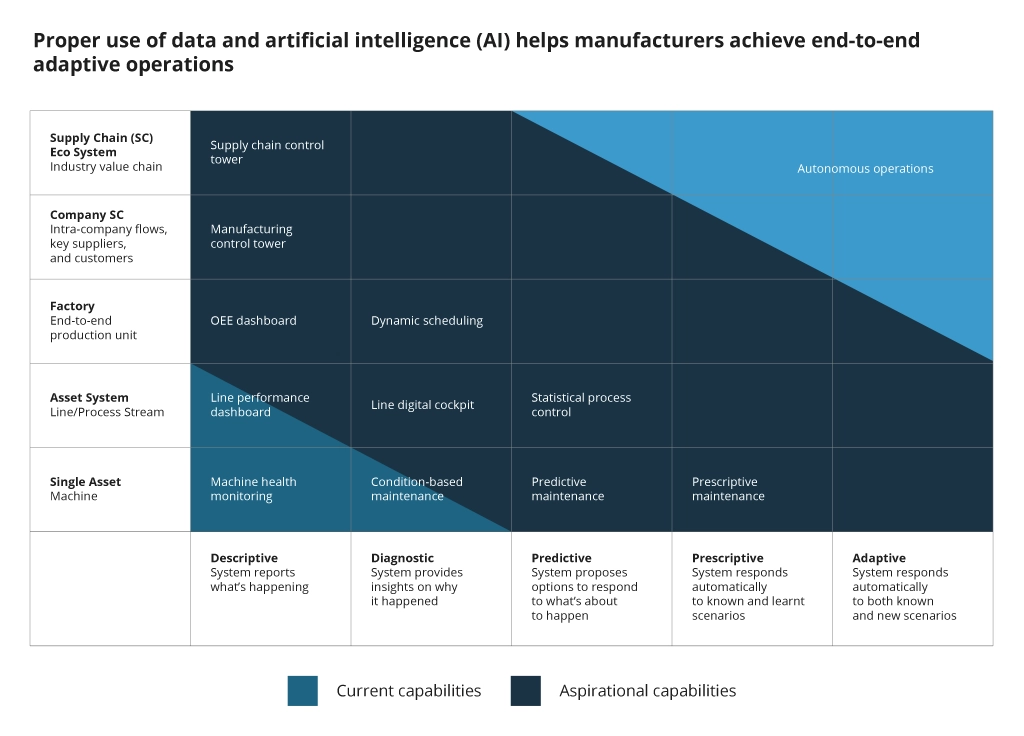
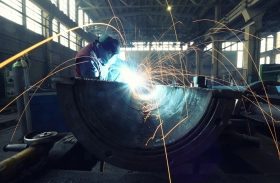
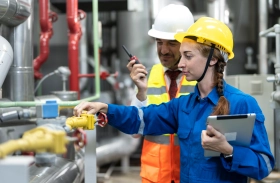

![ServiceNow for Manufacturing [Thumbnail]](/uploads/media/thumbnail-280x222-seven-ways-servicenow-drives-digital-transformation-in-manufacturing.webp)
![Manufacturing Trends 2024 [Thumbnail]](/uploads/media/thumbnail-280x222-manufacturing-trends-that-will-shake-the-world-in-2024.webp)
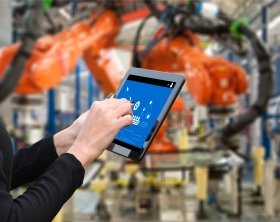
![Extended Reality for Manufacturing [thumbnail]](/uploads/media/the-place-of-extended-reality-280x222.webp)
